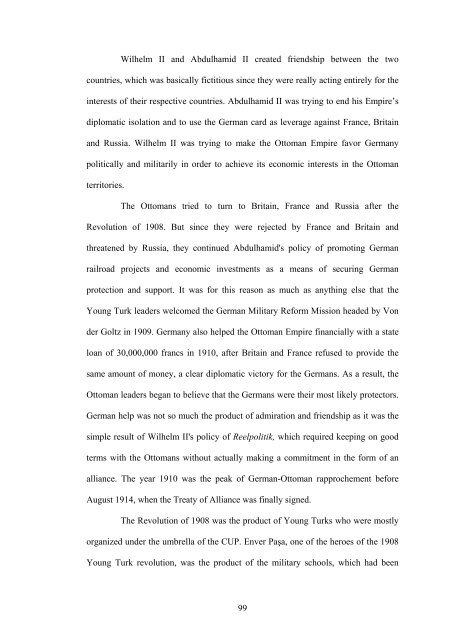the beginnings of ottoman-german partnership - Bilkent University
the beginnings of ottoman-german partnership - Bilkent University
the beginnings of ottoman-german partnership - Bilkent University
You also want an ePaper? Increase the reach of your titles
YUMPU automatically turns print PDFs into web optimized ePapers that Google loves.
Wilhelm II and Abdulhamid II created friendship between <strong>the</strong> two<br />
countries, which was basically fictitious since <strong>the</strong>y were really acting entirely for <strong>the</strong><br />
interests <strong>of</strong> <strong>the</strong>ir respective countries. Abdulhamid II was trying to end his Empire’s<br />
diplomatic isolation and to use <strong>the</strong> German card as leverage against France, Britain<br />
and Russia. Wilhelm II was trying to make <strong>the</strong> Ottoman Empire favor Germany<br />
politically and militarily in order to achieve its economic interests in <strong>the</strong> Ottoman<br />
territories.<br />
The Ottomans tried to turn to Britain, France and Russia after <strong>the</strong><br />
Revolution <strong>of</strong> 1908. But since <strong>the</strong>y were rejected by France and Britain and<br />
threatened by Russia, <strong>the</strong>y continued Abdulhamid's policy <strong>of</strong> promoting German<br />
railroad projects and economic investments as a means <strong>of</strong> securing German<br />
protection and support. It was for this reason as much as anything else that <strong>the</strong><br />
Young Turk leaders welcomed <strong>the</strong> German Military Reform Mission headed by Von<br />
der Goltz in 1909. Germany also helped <strong>the</strong> Ottoman Empire financially with a state<br />
loan <strong>of</strong> 30,000,000 francs in 1910, after Britain and France refused to provide <strong>the</strong><br />
same amount <strong>of</strong> money, a clear diplomatic victory for <strong>the</strong> Germans. As a result, <strong>the</strong><br />
Ottoman leaders began to believe that <strong>the</strong> Germans were <strong>the</strong>ir most likely protectors.<br />
German help was not so much <strong>the</strong> product <strong>of</strong> admiration and friendship as it was <strong>the</strong><br />
simple result <strong>of</strong> Wilhelm II's policy <strong>of</strong> Reelpolitik, which required keeping on good<br />
terms with <strong>the</strong> Ottomans without actually making a commitment in <strong>the</strong> form <strong>of</strong> an<br />
alliance. The year 1910 was <strong>the</strong> peak <strong>of</strong> German-Ottoman rapprochement before<br />
August 1914, when <strong>the</strong> Treaty <strong>of</strong> Alliance was finally signed.<br />
The Revolution <strong>of</strong> 1908 was <strong>the</strong> product <strong>of</strong> Young Turks who were mostly<br />
organized under <strong>the</strong> umbrella <strong>of</strong> <strong>the</strong> CUP. Enver Paşa, one <strong>of</strong> <strong>the</strong> heroes <strong>of</strong> <strong>the</strong> 1908<br />
Young Turk revolution, was <strong>the</strong> product <strong>of</strong> <strong>the</strong> military schools, which had been<br />
99
















